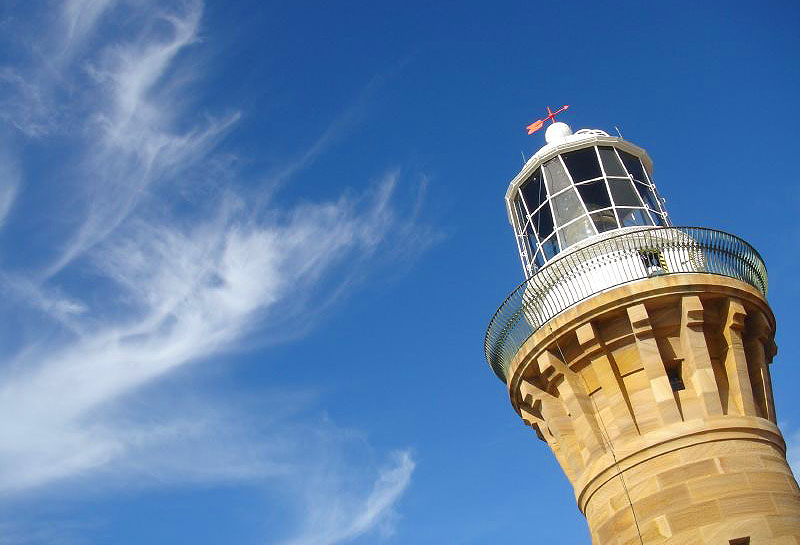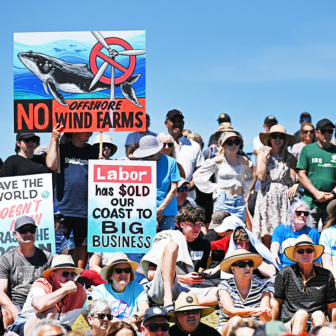Sydney Beaches: A History
By Caroline Ford | NewSouth | $39.99
Coast: A History of the New South Wales Edge
By Ian Hoskins | NewSouth | $49.99
At this time of year well over half the population heads for the beach, for a day, a week, or even a month. Most residents of this island continent know how to swim – a much higher proportion than in many other countries – and two of our capital cities, Perth and Sydney, are blessed with great surf beaches. Brisbane, unable to admit that it has no surf of its own, has colonised the Gold and Sunshine Coasts, and residents of the other coastal capitals head for their nearest beaches. Canberrans flock across the border to the NSW south coast, where generations of superannuants have built fibro shacks, some of which have been turned into luxury dwellings. Less well-off families and those who like the outdoors still go camping, where they mix with sometimes wealthy fishing and boating devotees.
The democracy of the Australian beach was nicely captured in the 1950s by the Scottish-born editor of the Sydney Morning Herald, John Douglas Pringle, who observed that “you cannot tell a man’s income in a pair of swimming trunks.” But this democracy, as Caroline Ford demonstrates in Sydney Beaches: A History, is much more a construct of the twentieth than of the nineteenth century. Using the rich resources of the NSW Archives, Ford takes a close look at the vital but often taken-for-granted matters of ownership and public access. She points, for instance, to the opening of commercial aquariums in Manly, Tamarama and Coogee in the late 1880s, all inspired by “similar enterprises on the British coast” using fresh salt water. (The reference to the British “coast” is a nice reminder that you can hardly describe Southend or Brighton as having a beach.) At Tamarama, the developers, in the language of the day, turned a “nearly useless” area into a “pleasant place for public amusement.”
Ford charts the rise of the surf lifesaving movement in Sydney, and the legalisation of daylight bathing. She describes the swift growth of increasingly elaborate surf clubs, the rise of the cult of suntanning, and the long-running disputes about swimming costumes. Public access to the beach remained central to the debate, and even a conservative government could oppose any further commercial development of beachside park land at Bondi in the late 1930s.
One of the main reasons why both sides of politics espoused freedom of the beach was that beachside land values continued to rise, sometimes spectacularly, especially if public transport was accessible. In Sydney’s case, this primarily involved a tram trip to the eastern suburbs beaches or the tram and ferry to Manly. Beachside camping, Depression-era camps and Aboriginal campers were forced out both by local government regulation and by rising land values. After the second world war, with the coming of mass car ownership, campers who could afford a private vehicle simply went further afield. Local governments, enjoying the extra rate income that the higher coastal land values delivered, favoured residents and daytrippers – who were also popular with beachside businesses – over campers. Parking became a battleground, and still is: unless you have a resident’s sticker, parking near a Sydney beach can be a very expensive undertaking.
Complaints about campers on Sydney beaches in the 1950s have their equivalent in present-day complaints about “illegal campers” on the beaches of northern New South Wales. Most commercial camping grounds on the NSW coast are still on crown leases, but both Labor and Liberal state governments have encouraged corporate groups to amalgamate these facilities and build highly priced cabins for the holiday trade. Older permanent residents rightly fear expulsion.
To the visitor today, one of the most extraordinary aspects of the NSW coast is the sheer number and size of stone walls projecting out into the ocean, designed to create safe entry and exit for fishing vessels. Although the NSW coast offers many natural havens – from Twofold Bay to the inlet and lake systems of mid and northern New South Wales – the state’s public works department found it hard to resist creating ever more coastal entry points, from Brunswick Heads in the north to Ulladulla in the south. Even grander interventions were planned, and often implemented, at the bigger coastal river ports, including a plethora of breakwaters at Ballina on the Richmond River and at Nambucca Heads. Coastal ports that became the sites of steelworks, notably Port Kembla and Newcastle, saw enormous intervention in the landscape for wharf and rail facilities.
These developments are part of the broader history that Ian Hoskins covers in his handsomely illustrated book, Coast. Deftly mixing chronology and theme, Hoskins traces the rich evolution of the coastline from the time when coastal tribes harvested food from the sea and estuarine lakes up to the development of harbours and coastal real estate.
Hoskins tells us about whaling and whale watching from Eden to Byron Bay, but he doesn’t mention that the Bryon Bay whaling station exists because of a 1954 cyclone that wiped out most of the pier, with the local abattoir owner cheaply leasing the remnant structure to start a whaling station. Like the station at Tangalooma, on Moreton Island, the whales were cut up for pet food. Both stations closed in 1962, not because of conservationists’ worries about whaling, but because the whalers had run out of humpbacks to kill.
In fact, if historical oddities catch your attention, it is hard to go past the Eden Killer Whale Museum or, just as evocative, the extraordinary tower the egomaniac whaler Ben Boyd built at Red Head, on Twofold Bay, with his surname carved in stone atop each of its four sides. Even in the early twentieth century, Hoskins tells us, local European and Indigenous men pursued humpbacks in open boats. What an evocative landscape our national capital would have if the Twofold Bay Development League’s bid to house the capital had won out against Canberra. And just think of all those car trips to the coast that would have been unnecessary.
Today, the greatest threat to beaches and coastlines comes not from maritime invasion or sand mining, but from a rising sea level, storms and cyclones. This is what has the insurance actuaries working overtime and the rest of us paying through the nose in rising insurance bills. The owners of luxury houses and apartment blocks, which are often built at the back of sand dunes, must face the possibility that their foundations will erode and their yards could be lost. This has happened in Sydney – Ford’s book has a striking photo of 1974 storm damage at North Cronulla – and on the Gold Coast.
If you think these are isolated cases promoted by climate change activists, take a look at Belongil Beach, just north of Byron Bay, where wealthy landowners have managed to prevail on the local council to put rock walls in front of their waterside mansions. Why any council should feel pressured into propping up the beachfront properties of the wealthy is beyond me, especially when all the evidence points to continuing erosion. Some of the most egregious beachfront owners, from the Mornington Peninsula to the Gold Coast, are attracted, of course, by the idea that the public should be banned from walking along their bit of the beach.
Coastal development, as both these books point out, has always made commercial sense. There is a lot of money to be made on or near the beach. During the nineteenth century, grand beachside structures, from guest houses to amusement parks, clustered on the coast. For most of the twentieth century, especially with the rise of the surf lifesaving movement, freedom of the beach came to be an assumed part of Australian life. Many beach developments went bust, not least Henry Halloran’s 1915–16 Pacific City subdivision at Jervis Bay and St Georges Basin, and his bold effort during the Great War to capitalise on the assumed growth of the Canberra market. Such unabashed wartime speculation would hardly qualify him for retrospective membership of Team Australia, so perhaps a posthumous knighthood would be more appropriate.
With the passage of strata title acts in the 1960s, developers increasingly began building apartment blocks. Hoskins reproduces a 1963 Max Dupain photograph of Seidler’s pristine Diamond Bay flats, on the rocky foreshore at Dover Heights. While the sandstone foundations here are solid, its proximity to the Pacific Ocean means that concrete cancer is a constant threat (though newer apartment blocks will allegedly be able to withstand that problem). Since the 1990s, many beachside developments incorporate commercial uses on the ground floor, most profitably cafes and bars. This commerce often spills onto the beach; during Schoolies Week, the liquor spills as well. And when surf clubs become gambling and alcohol venues, their lifesaving activities often become a charitable backdrop to a strong commercial cashflow. Unlike the traditional beach hotel – including the decrepit but still functioning Sedgers Reef Hotel at Iluka – most NSW surf clubs are on crown land and do not pay council rates. In marked contrast to their Queensland equivalents, though, the NSW clubs have rarely succumbed to the temptation to make gambling a central activity.
Both books tackle some of the less savoury aspects of life on the coast, including the Cronulla Riots of 11 December 2005, when (according to one witness) “alcohol fuelled the racism and racism fuelled the alcohol.” Ford points to the use of our harbours, rivers and beaches for the disposal of sewage and stormwater.
Generations of environmentalists have campaigned about the richness of coastal wild life and landscapes. Hoskins demonstrates that a third of the NSW coast is protected by national parks and reserves, some of them under Indigenous management and known by their original tribal names. The sand mines that blighted the beach and ruined the dunes from Kingscliff to Killcare were closed after vehement protests. To our national shame, the LNP government in Queensland has extended the sand-mining leases at Stradbroke Island.
If you are on or near any Australian beach this summer, Sydney’s Beaches, in a handy paperback format, makes for a good read, and forces you to reflect on the fact that we can’t take freedom of the beach for granted, as Keith Dunstan so eloquently pointed out in Walkabout magazine in 1963. If your interest in coastal history extends to map making, fishing, shipping, whaling, harbours and lighthouses, then Coast, a substantial but reasonably priced hardcover tome, will take your fancy. In an age when we can check traffic jams between us and the beach on Google Maps and look at webcams for surf conditions, we really do need well researched and well written coastal histories to give us social and economic context. Sydney and New South Wales are well served by these two books. They have no equivalent in any other state. •




